IMRD Overview_файл2 параллельно с 1.ppt
- Количество слайдов: 12
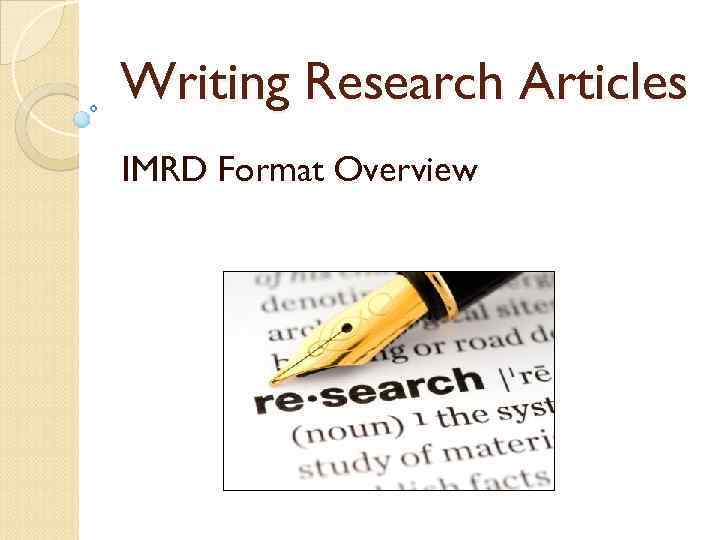 Writing Research Articles IMRD Format Overview
Writing Research Articles IMRD Format Overview
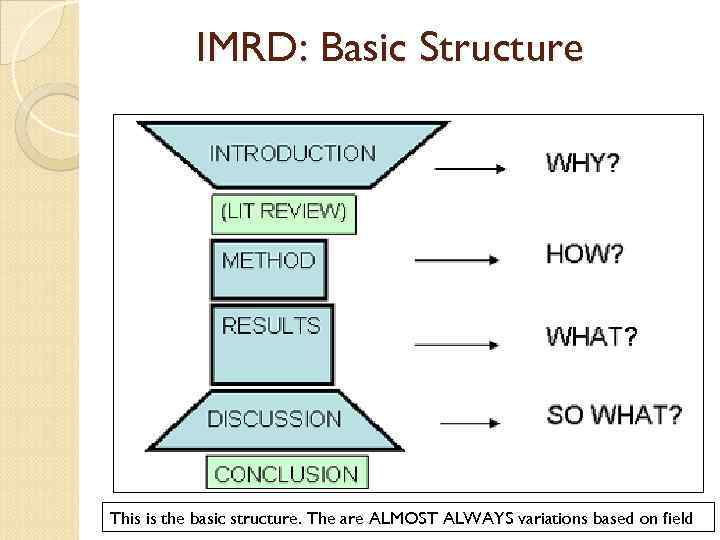 IMRD: Basic Structure This is the basic structure. The are ALMOST ALWAYS variations based on field
IMRD: Basic Structure This is the basic structure. The are ALMOST ALWAYS variations based on field
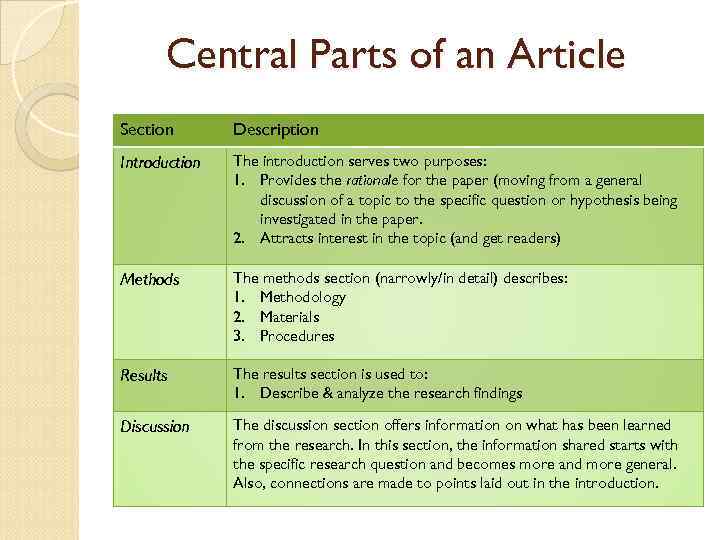 Central Parts of an Article Section Description Introduction The introduction serves two purposes: 1. Provides the rationale for the paper (moving from a general discussion of a topic to the specific question or hypothesis being investigated in the paper. 2. Attracts interest in the topic (and get readers) Methods The methods section (narrowly/in detail) describes: 1. Methodology 2. Materials 3. Procedures Results The results section is used to: 1. Describe & analyze the research findings Discussion The discussion section offers information on what has been learned from the research. In this section, the information shared starts with the specific research question and becomes more and more general. Also, connections are made to points laid out in the introduction.
Central Parts of an Article Section Description Introduction The introduction serves two purposes: 1. Provides the rationale for the paper (moving from a general discussion of a topic to the specific question or hypothesis being investigated in the paper. 2. Attracts interest in the topic (and get readers) Methods The methods section (narrowly/in detail) describes: 1. Methodology 2. Materials 3. Procedures Results The results section is used to: 1. Describe & analyze the research findings Discussion The discussion section offers information on what has been learned from the research. In this section, the information shared starts with the specific research question and becomes more and more general. Also, connections are made to points laid out in the introduction.
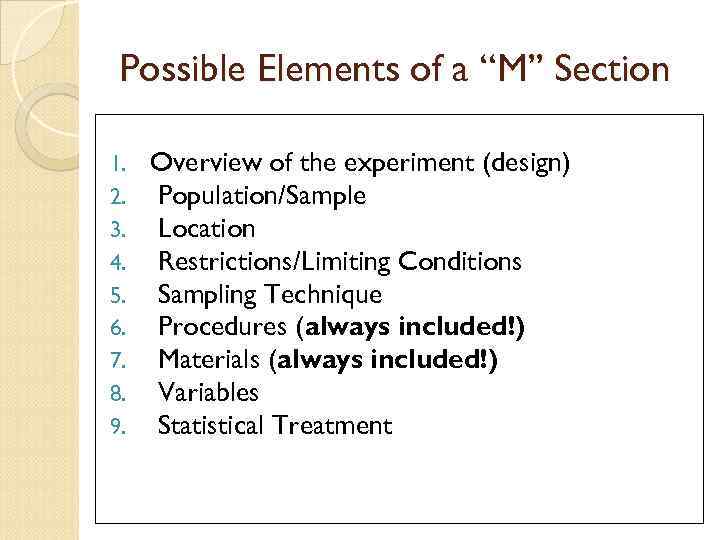 Possible Elements of a “M” Section 1. 2. 3. 4. 5. 6. 7. 8. 9. Overview of the experiment (design) Population/Sample Location Restrictions/Limiting Conditions Sampling Technique Procedures (always included!) Materials (always included!) Variables Statistical Treatment
Possible Elements of a “M” Section 1. 2. 3. 4. 5. 6. 7. 8. 9. Overview of the experiment (design) Population/Sample Location Restrictions/Limiting Conditions Sampling Technique Procedures (always included!) Materials (always included!) Variables Statistical Treatment
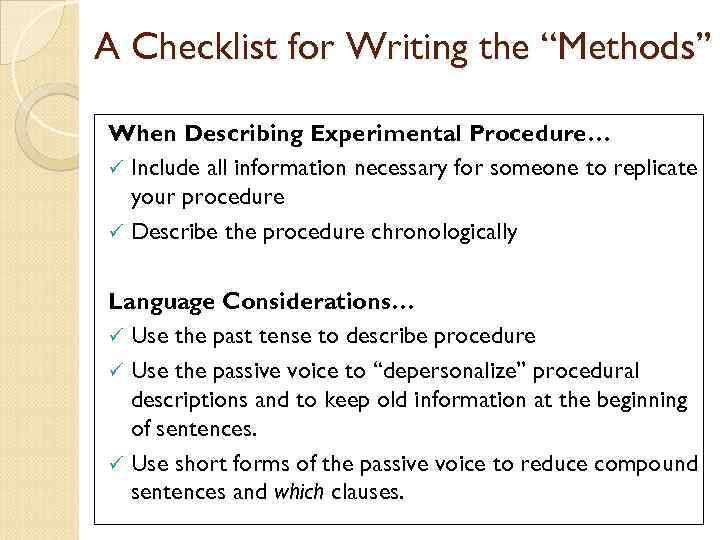 A Checklist for Writing the “Methods” When Describing Experimental Procedure… ü Include all information necessary for someone to replicate your procedure ü Describe the procedure chronologically Language Considerations… ü Use the past tense to describe procedure ü Use the passive voice to “depersonalize” procedural descriptions and to keep old information at the beginning of sentences. ü Use short forms of the passive voice to reduce compound sentences and which clauses.
A Checklist for Writing the “Methods” When Describing Experimental Procedure… ü Include all information necessary for someone to replicate your procedure ü Describe the procedure chronologically Language Considerations… ü Use the past tense to describe procedure ü Use the passive voice to “depersonalize” procedural descriptions and to keep old information at the beginning of sentences. ü Use short forms of the passive voice to reduce compound sentences and which clauses.
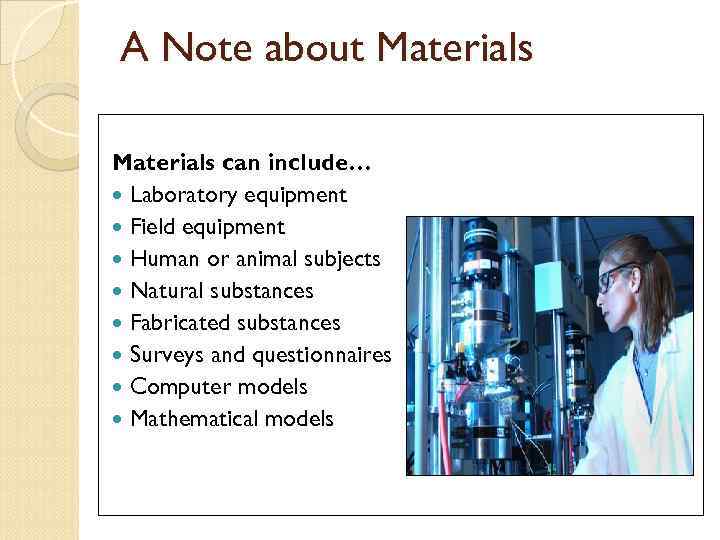 A Note about Materials can include… Laboratory equipment Field equipment Human or animal subjects Natural substances Fabricated substances Surveys and questionnaires Computer models Mathematical models
A Note about Materials can include… Laboratory equipment Field equipment Human or animal subjects Natural substances Fabricated substances Surveys and questionnaires Computer models Mathematical models
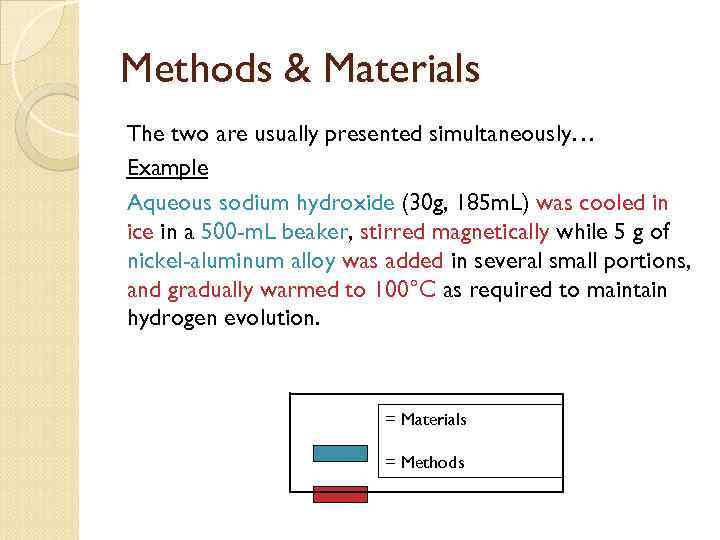 Methods & Materials The two are usually presented simultaneously… Example Aqueous sodium hydroxide (30 g, 185 m. L) was cooled in ice in a 500 -m. L beaker, stirred magnetically while 5 g of nickel-aluminum alloy was added in several small portions, and gradually warmed to 100°C as required to maintain hydrogen evolution. = Materials = Methods
Methods & Materials The two are usually presented simultaneously… Example Aqueous sodium hydroxide (30 g, 185 m. L) was cooled in ice in a 500 -m. L beaker, stirred magnetically while 5 g of nickel-aluminum alloy was added in several small portions, and gradually warmed to 100°C as required to maintain hydrogen evolution. = Materials = Methods
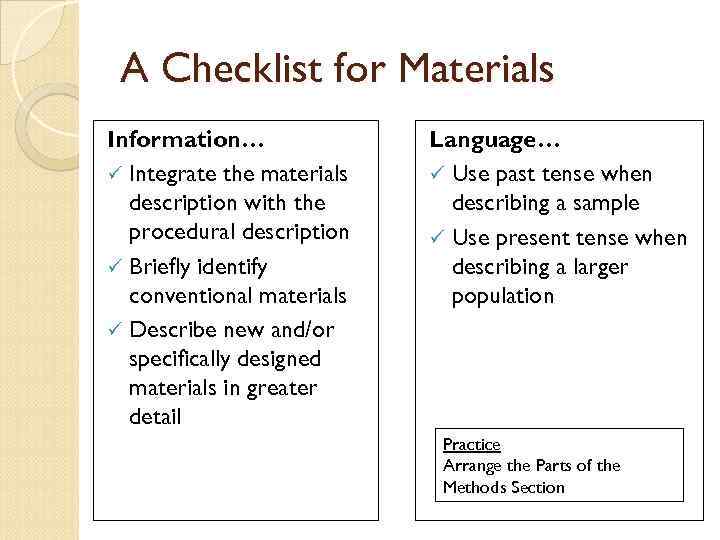 A Checklist for Materials Information… ü Integrate the materials description with the procedural description ü Briefly identify conventional materials ü Describe new and/or specifically designed materials in greater detail Language… ü Use past tense when describing a sample ü Use present tense when describing a larger population Practice Arrange the Parts of the Methods Section
A Checklist for Materials Information… ü Integrate the materials description with the procedural description ü Briefly identify conventional materials ü Describe new and/or specifically designed materials in greater detail Language… ü Use past tense when describing a sample ü Use present tense when describing a larger population Practice Arrange the Parts of the Methods Section
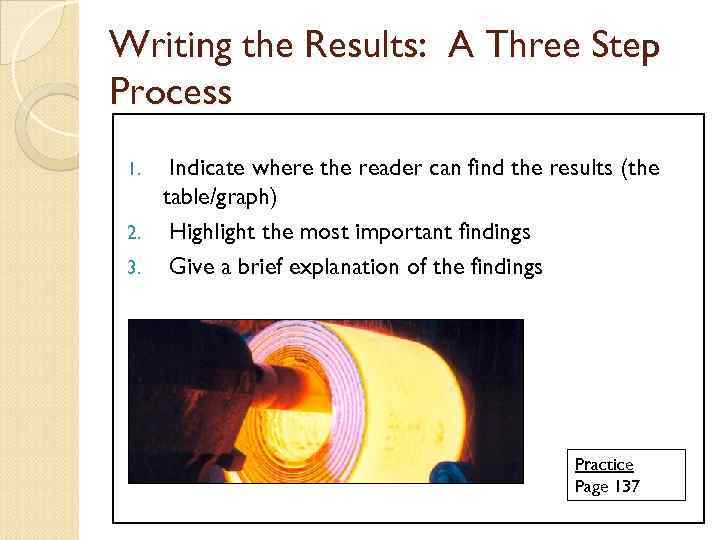 Writing the Results: A Three Step Process Indicate where the reader can find the results (the table/graph) 2. Highlight the most important findings 3. Give a brief explanation of the findings 1. Practice Page 137
Writing the Results: A Three Step Process Indicate where the reader can find the results (the table/graph) 2. Highlight the most important findings 3. Give a brief explanation of the findings 1. Practice Page 137
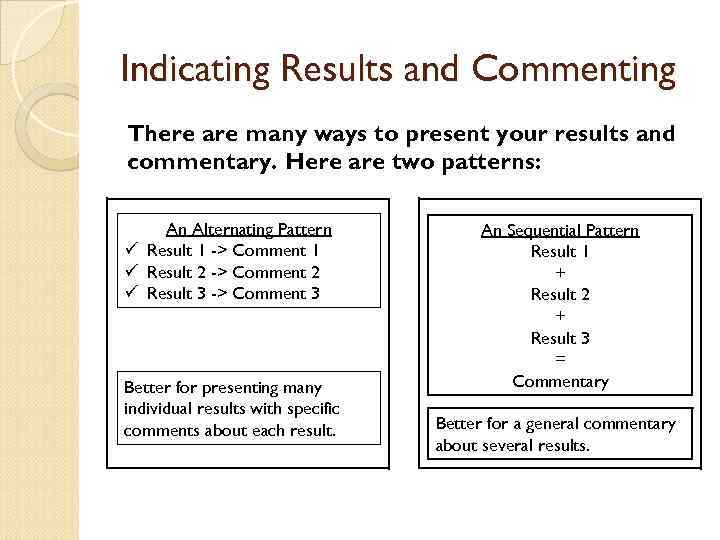 Indicating Results and Commenting There are many ways to present your results and commentary. Here are two patterns: An Alternating Pattern ü Result 1 -> Comment 1 ü Result 2 -> Comment 2 ü Result 3 -> Comment 3 Better for presenting many individual results with specific comments about each result. An Sequential Pattern Result 1 + Result 2 + Result 3 = Commentary Better for a general commentary about several results.
Indicating Results and Commenting There are many ways to present your results and commentary. Here are two patterns: An Alternating Pattern ü Result 1 -> Comment 1 ü Result 2 -> Comment 2 ü Result 3 -> Comment 3 Better for presenting many individual results with specific comments about each result. An Sequential Pattern Result 1 + Result 2 + Result 3 = Commentary Better for a general commentary about several results.
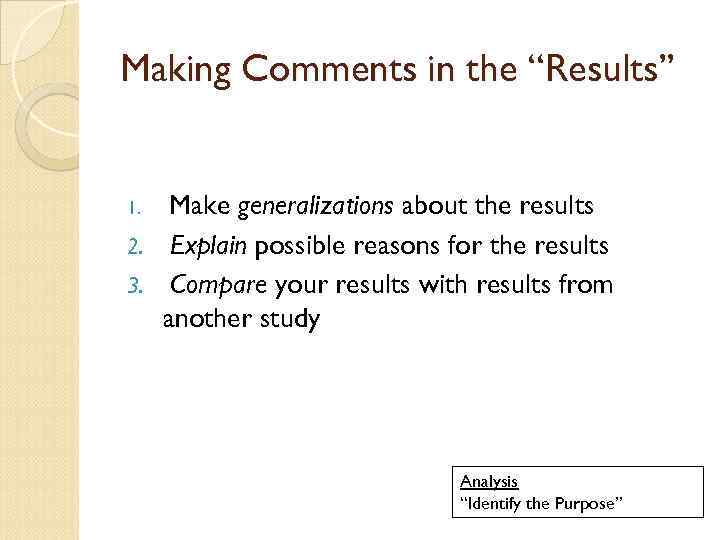 Making Comments in the “Results” Make generalizations about the results 2. Explain possible reasons for the results 3. Compare your results with results from another study 1. Analysis “Identify the Purpose”
Making Comments in the “Results” Make generalizations about the results 2. Explain possible reasons for the results 3. Compare your results with results from another study 1. Analysis “Identify the Purpose”
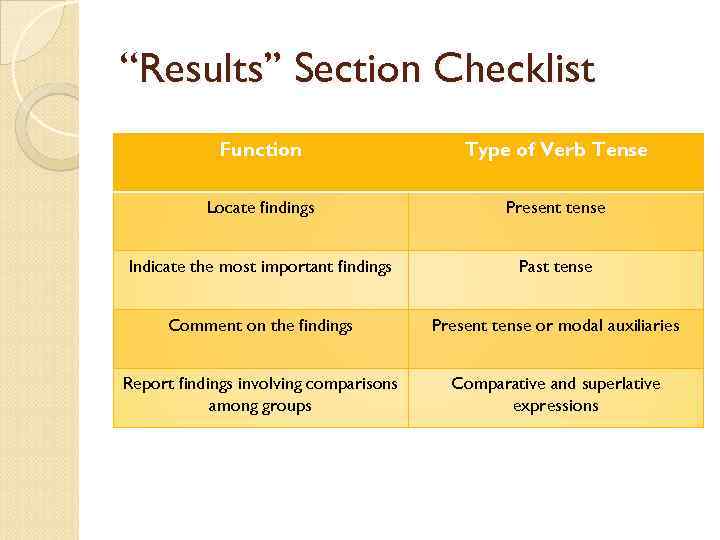 “Results” Section Checklist Function Type of Verb Tense Locate findings Present tense Indicate the most important findings Past tense Comment on the findings Present tense or modal auxiliaries Report findings involving comparisons among groups Comparative and superlative expressions
“Results” Section Checklist Function Type of Verb Tense Locate findings Present tense Indicate the most important findings Past tense Comment on the findings Present tense or modal auxiliaries Report findings involving comparisons among groups Comparative and superlative expressions


